Survey: Leadership Preparedness Improves, but Gaps Remain

MLC’s Digital Leadership survey finds that while more organizations have restructured to build an M4.0 advantage, organizational readiness continues to lag.
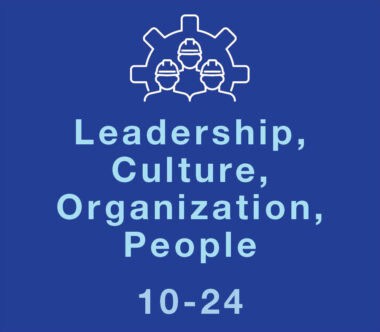
KEY TAKEAWAYS:
● Digital manufacturing leaders need to build traditional leadership qualities with new skills such as fostering a data-driven culture and guiding the workforce through change.
● Despite progress in creating digital strategies, many manufacturers lack formal training programs for upskilling their workforce, and many feel that leadership is unprepared for the future.
● Effective digital leadership is characterized by collaboration both internally and externally, while successfully building and navigating digital ecosystems.
While there are many tried-and-true qualities of good leadership that stand the test of time – innovation, integrity, confidence – the additional skills required of digital manufacturing leaders have evolved just like the technologies giving rise to Manufacturing 4.0.
Today’s operational leaders need an eye toward building data-driven business cultures and decision-making; the ability to collaborate with teams both inside and outside of their organization; the skill to help their teams adapt in times of change; and much more. There are also more traditional leadership skills that look different than they used to; for example, continuous improvement in a digital ecosystem, and a focus on upskilling the workforce on new technologies and methodologies.
The Manufacturing Leadership Council’s 2024 Digital Leadership survey reveals that while organizational structures are adjusting to the needs for digital manufacturing, there are still gaps to address for full business readiness.
Section 1: The Organizational Motto: Be (Mostly) Prepared
Anyone who has been involved with a scouting organization in their youth is likely to recall the famous motto: “Be Prepared.” It seems that more digital manufacturing leaders, as well as their organizations, are (mostly) coming around to this motto as good advice. But at the same time, more than half of manufacturers are not offering any formal digital training to educate or upskill the workforce and leadership (Chart 3), and 88% of respondents feel that their company’s future has at least some future vulnerability due to its current digital transformation preparedness (Chart 5).
Meanwhile, more organizations have created a change management strategy around digital transformation (Chart 1) and/or have restructured or redesigned themselves to better manage digitalization (Chart 2). But understanding the digital roles and skills that will be required by the future manufacturing enterprise is only somewhat understood by most (Chart 4.)
1. Most Have a Change Management Strategy in Place
Q: Has your leadership team created an organizational change management strategy to help support its digital strategy? (Select one)
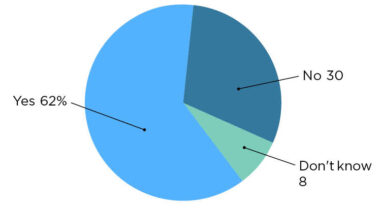
2. Organizations are Restructuring Around Digital
Q: As part of its digital transformation work, has your company undertaken organizational redesign to better manage the impact of digitalization? (Select one)
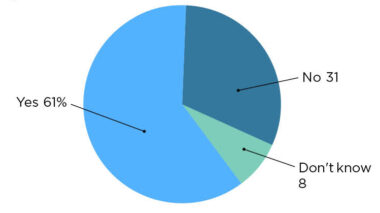
3. Still, Formal Training Programs are Lacking
Q: Does your company have a formal training plan to educate workers and leadership around the requirements of digital transformation? (Select one)
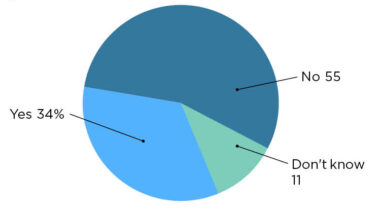
4. Future Roles and Skills Needs Only Somewhat Understood
Q: How well prepared do you think your company is in understanding the new digital roles and skills that you will need in the next few years? (Select one)
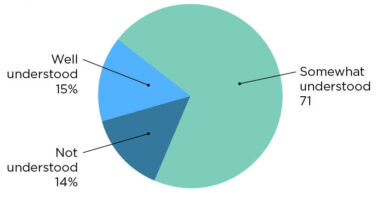
5. Current Levels of Digital Readiness Create Vulnerabilities
Q: How vulnerable will your company’s future success be as a direct result of your company’s current level of digital transformation preparedness? (Select one)
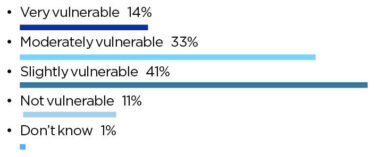
Section 2: Digital Leadership is a Team Sport
As technology enables individuals and teams to become more connected both internally and to external customers and partners, the ability to collaborate is key. So too is it key among leadership teams, as leaders need to understand the impact that digital investment and deployment will have on different areas of the enterprise. The top response for “who is in charge” for digital transformation efforts was that it is a collaborative effort (Chart 6). It’s likely a positive sign that most respondents — 85% — rates their leadership teams as either “highly” or “somewhat” collaborative (Chart 8).
Perhaps unsurprisingly, executive management teams most frequently want to know the value of digital investments – the business case for them, and what specific use cases will bring the most bang for the buck (Chart 7). But only 23% rate their executives as “very prepared” to lead and manage digital transformation (Chart 9).
6. Leadership is Most Often Collaborative
Q: Who is leading the charge around the digital transformation efforts in your organization?

7. Executives Most Often Want to Know Business Value
Q: What is the most important thing your company’s executive management team wants to know about digital transformation? (Select top 3)
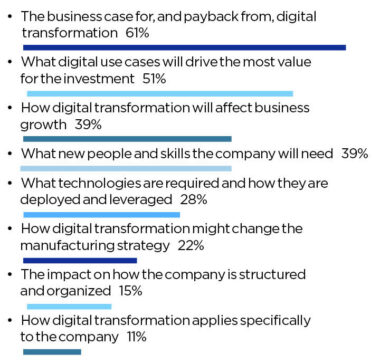
8. Cross-Organizational Leaders Collaborate on Strategy
Q: How collaborative is your leadership team across multiple areas of the organization in the development and assessment of its digital strategy? (Select one)
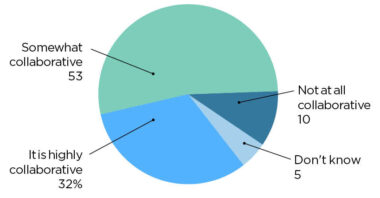
9. Executive Management is Only Somewhat Prepared for Digital Transformation
Q: How prepared do you think your company’s executive management team is to lead and manage digital transformation? (Select one)

Section 3: The Meaning of Leadership in the M4.0 Era
When asked which statements best describe an M4.0 leader, ecosystem-based external and internal collaboration once again came up as a key theme, along with understanding technology integration and creating an information-driven culture (Chart 10). Additionally, most respondents — 74% — believe that digital operations require a substantially different approach and skill set for leaders (Chart 11).
As for the skills and abilities that respondents believe are most important, the highest degree of importance was placed on using digital technology to reduce costs and improve efficiency, followed by the willingness and ability to rethink traditional business to successfully embrace a digital model (Chart 13).
In business, the definition of a good leader has been and will continue to be one who inspires and brings out the best in others, in addition to making smart business decisions to bring about success. Technology is a burgeoning part of the play, but those individuals who dare to act as visionaries in creating winning strategies will continue to be the ones who find success. N
10. Leaders Must Navigate Digital Ecosystems and Understand Digital Integration
Q: Which statements best describe what leadership means in the digital era? (Select top 3)
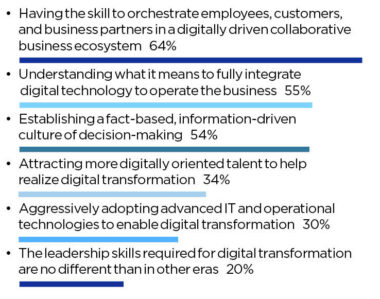
11. Digital-Era Leadership Requires a Substantially Different Approach
Q: Do you agree or disagree with this statement: The emergence of digitally driven operations and business models will require a substantially different approach and set of skills on the part of manufacturing company leadership. (Select one)
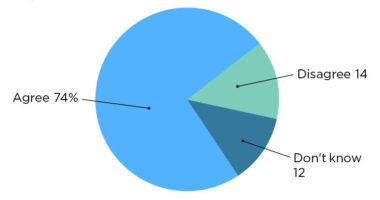
12. Digital Acumen, Building a Data-Driven Culture Most Important for Leaders
Q: Which leadership approaches do you feel are most important in the digital era? (Select top 3)
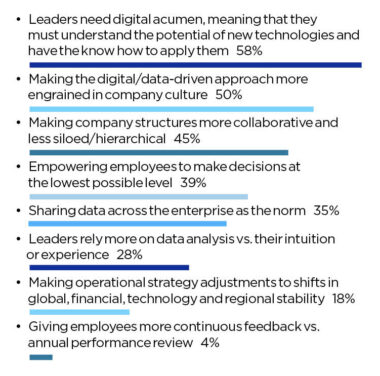
13. Most Important Skills: Reimagined Business Models; Successful Technology Deployment
Q: Looking ahead, what degree of importance would you assign to the following digital leadership skills and abilities? (Rate each on scale of Low/Medium/High)
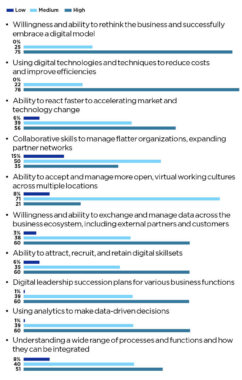
About the author:

Penelope Brown Senior Content Director, Manufacturing Leadership Council